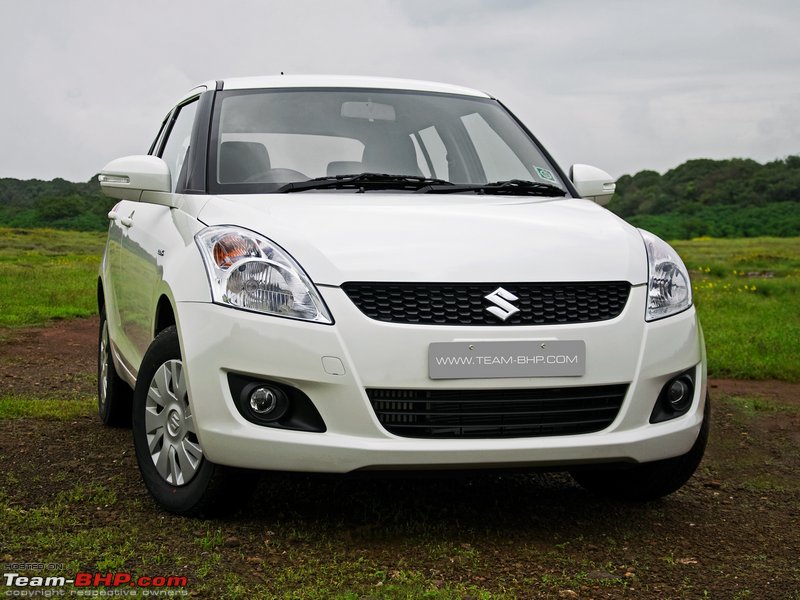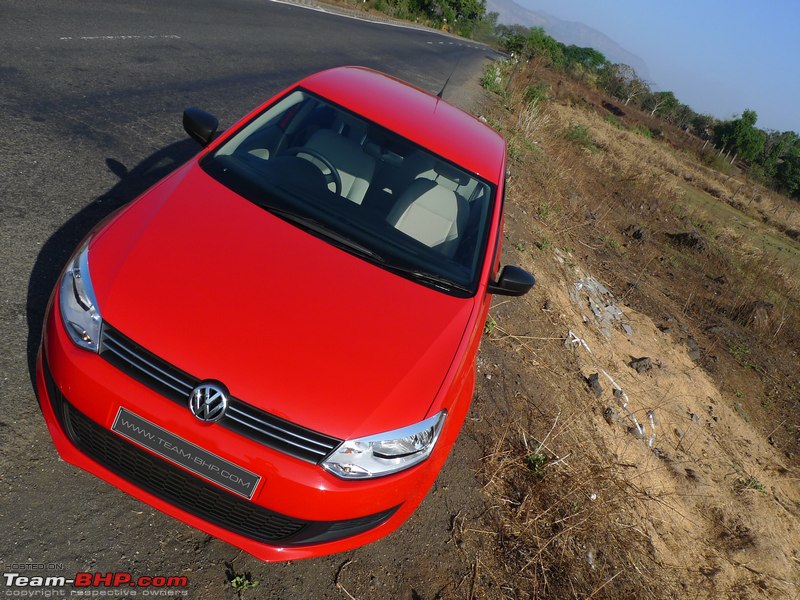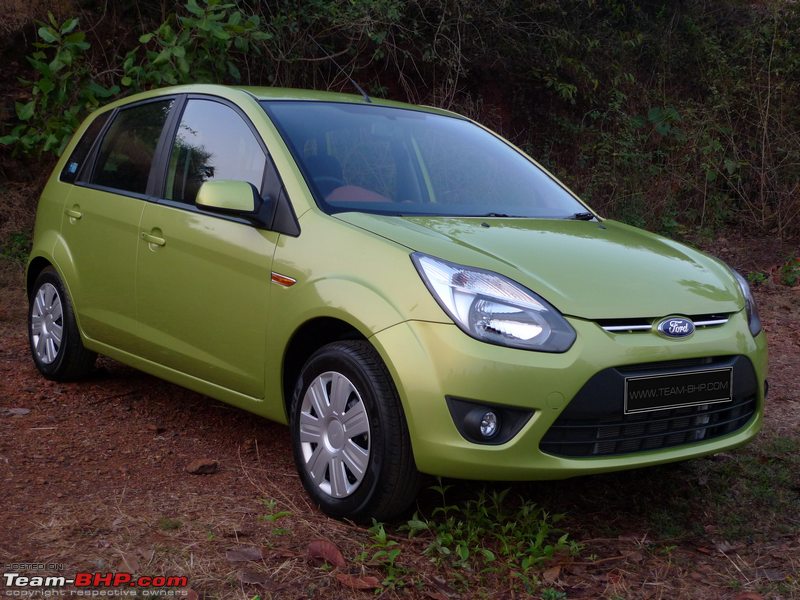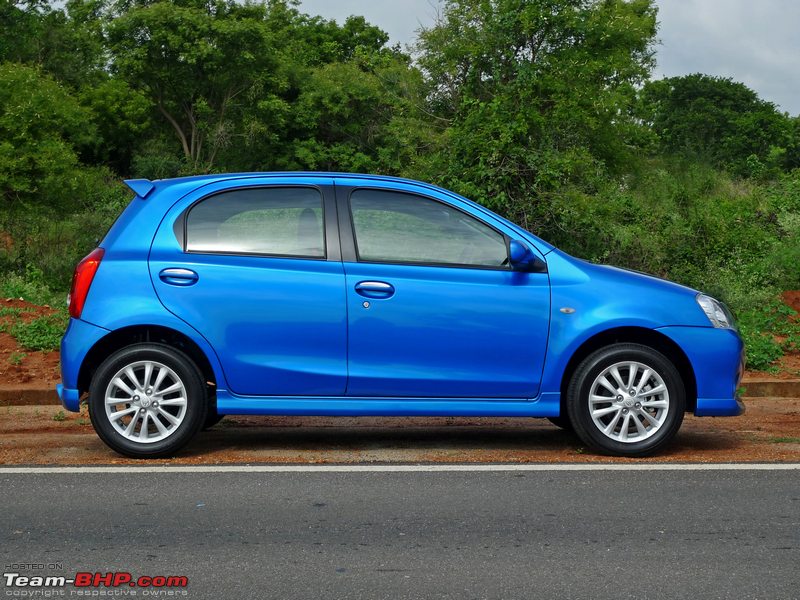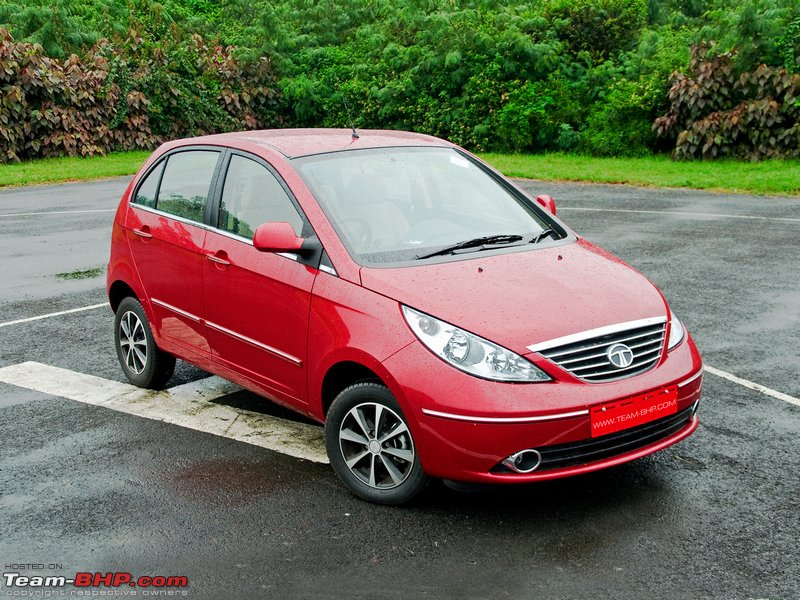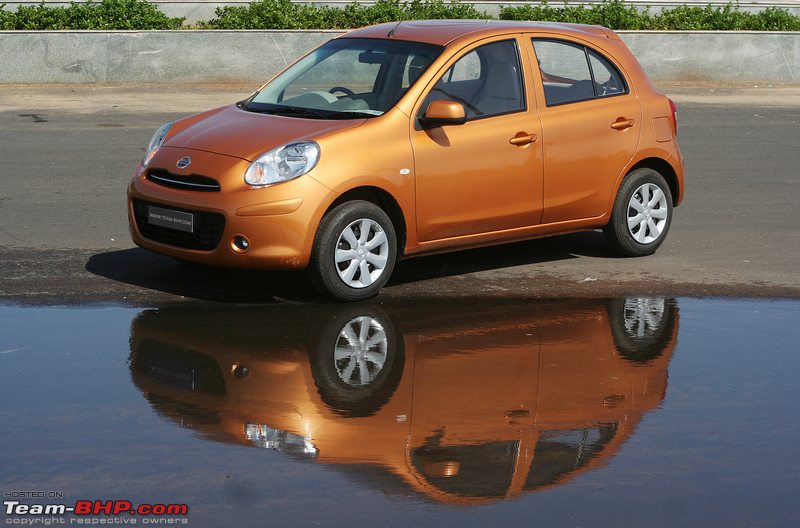| |||||||
| Search Forums |
| Advanced Search |
| Go to Page... |
 |
| Search this Thread |  1,361,838 views |
| | #1 |
| Team-BHP Support  | 1st-gen Hyundai i20 (2008 - 2014) : Review The 2012 Hyundai i20 has been launched in India at a price of between 4.73 - 7.67 Lakhs (ex-Delhi). What you’ll like: • Top notch quality inside out. New Fluidic styling works • Class-leading equipment list (auto headlamps & wipers, keyless entry & go, reverse camera, electric folding ORVMs etc.) • Fast, fuel-efficient diesel engine mated to a smooth 6 speed gearbox • Amongst the more spacious hatchbacks. Comfortable for 4, or even the occasional 5 • Big, practical 295 liter boot • 5 star safety equipment & rating. Upto 6 airbags, all-wheel disc brakes, ABS & EBD What you won’t: • Underpowered 1.2L petrol engine. Offers mediocre performance on the expressway • Light, vague & sensitive steering at speed • Highway dynamics are unfitting of a premium hatchback • Diesel i20 carries an unusually high difference of ~1.5 lakhs (on the road) over the petrol • Asta variants are priced in the vicinity of bigger, more powerful sedans • Hyundai's service costs are usually higher than that of the competition The 2014 Hyundai Elite i20: • Review Link 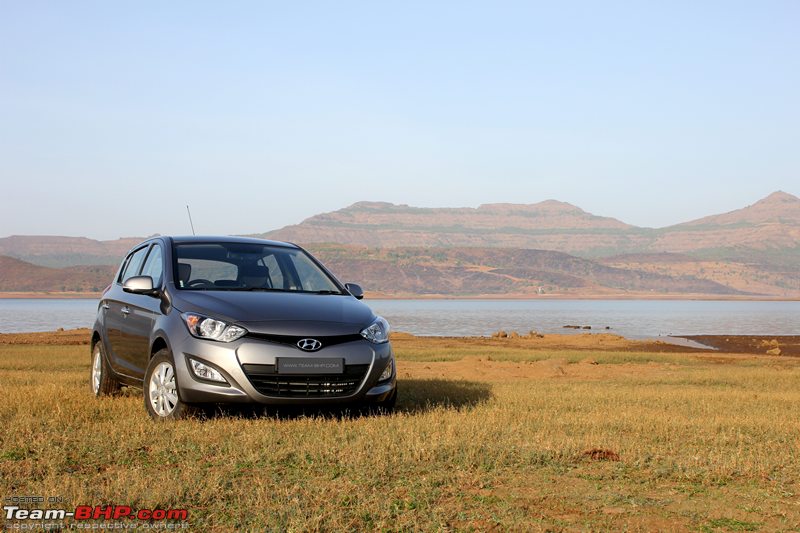 Last edited by Rehaan : 3rd September 2014 at 10:55. |
| |  (33)
Thanks (33)
Thanks
|
| The following 33 BHPians Thank GTO for this useful post: | .anshuman, AdityaDeane, anjan_c2007, CoolBlueBiker, coriollis, deetjohn, DexterMorgan, dkaile, Guna, haisaikat, highway_star, jk007, jkdas, Leymama, Motored Mindset, mukeshgoel, Patriot_Vishwas, RavenAvi, Rehaan, Reinhard, RSR, scopriobharath, Sheel, sidindica, SmartCat, sridhar24, swiftnfurious, Technocrat, theexperthand, Wildy, wordsworth, zipzap, _raVan_ |
| |
| | #2 |
| Team-BHP Support  | re: 1st-gen Hyundai i20 (2008 - 2014) : Review 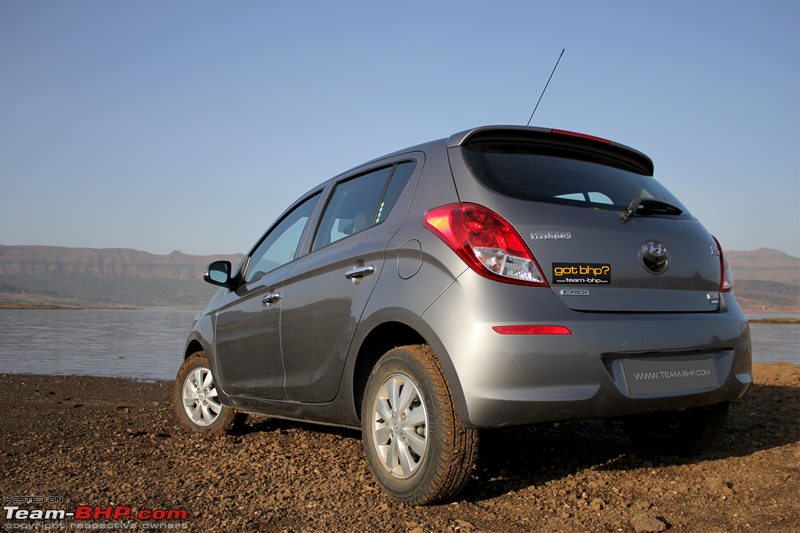 The i20's India story is quite a spectacular one. Launched in December 2008, Hyundai's internal sales projections for the premium hatchback were ~1,000 units a month. The i20's domestic sales didn't really matter at the time, since Hyundai had primarily set up the production line for exports to Europe. In fact, i20 exports began before the car's Indian launch, and the company was already shipping 6,000 - 7,000 units a month by early 2009. The market's initial response exceeded the company's modest targets. Still, sales performance was nowhere close to the levels seen in the 2010 - 2012 period, because the i20 was perceived as an expensive hatchback at the time. Then, the Jazz came home! Honda adopted a ridiculous pricing strategy for the Jazz, effectively killing the product within 60 seconds of launch. Overnight, the i20 became a value-for-money proposition. Leaving the entry & mid-level variants aside, even the full blown i20 Asta (O) was a whopping 1.2 lakhs cheaper than the Honda Jazz, and that's with a far superior equipment list (6 airbags et al). The fact that the Indian car market was just entering a stupendous growth phase helped. In the most recent 3 year period, the i20 has gone from strength to strength. And for the last 12 months, the car has maintained average monthly sales of 6,500. The face-lifted i20 arrives 3.5 years into the product lifecycle; that's about the ideal time for a refreshment. Hyundai has given the i20 a new face, and also addressed some issues of the older car. Yes, a urethane bush & modified steering rack have been added to take care of the steering rattle issue. The headlamp's spread and power have improved, while the air-conditioning is more effective. Vanity mirrors find their way onto the sun-visors and the cabin gets two lamps (one in the center, the other at the front). The suspension has been slightly retuned though, I must add, this has done nothing for her high speed manners. Low speed ride comfort has become noticeably better. I'm a huge fan of the i20's aggressive new face. In person especially, the i20 looks much like a European car, and appears to take inspiration from the VW school of design. The staid side profile is largely unchanged in the facelift and is definitely the most unappealing angle to view the car in. The 14" wheels look rather small for a car of this size, and I'm surprised Hyundai isn't giving the top-end variants 15" wheels (a size that the Swift ZXi / ZDi get). I quite like the clean & proportionate rear end, though the casual observer won't even notice the new lamps, bumper or spoiler. Except for the front end treatment, the rest of the facelift changes are the "blink and you'll miss it" type. The overall design language will please all and offend none. I have two complaints. One, the small 14" wheels and relatively thin 185mm tyres. 195/55 R15 footwear would have led to a more planted stance, and made the i20 dynamically richer too. My second complaint is on the boring 6-colour palette. There are no black or dark blue body colour options (available in the pre-facelift), and I wish Hyundai had experimented with additional metallic shades (maroon, green, blue etc.) that are befitting of a premium hatchback. The i20's high level of quality is evident the minute you approach the car. The paint job is top notch, while panel shut-lines are slim & consistent. Hyundai could teach its Chennai neighbour, Nissan, a thing or two in this area. On the flip side, build solidity cannot be compared to other European cars such as the Polo, Punto or Fabia. The sheet metal feels noticeably thinner & lighter. There is none of that satisfying "t-h-u-d" when you shut the doors. Don't get me wrong, the i20's construction is high quality, but it's just not built like the proverbial tank. The i20 is now available in 12 variants with multiple engine & transmission options. The entry-level petrol & the high-end Automatic are spread apart by a whopping 3 lakh rupees! The variants span across the "affordable" price point to the "expensive". The Asta variants can easily embarrass some 30 lakh rupee sedans in an equipment shootout. The Asta Option pack with 6 airbags & a sunroof is only available with the 1.2L petrol engine though. What's new in the facelift? An engine start / stop button, pure keyless entry, auto headlamps, rain sensing auto wipers, a very-useful driver armrest, rear parking sensors, rear view camera, auto-dimming rear view mirror and some miscellaneous items. Suffice to say that most competitors (Polo, Swift, Fabia, Jazz, Liva) look bare naked in comparison. I am extremely surprised that Hyundai hasn't equipped the i20 with an MID that offers data on average / real-time fuel-efficiency, or the useful distance to empty counter. The 5th alloy wheel (spare wheel) has been silently removed. Ironically, auto-locking doors are only available on the Asta (O) variant, albeit Hyundai dealerships are known to activate this functionality for the lower variants on customer request. Classy European face will remind you of some Volkswagens: 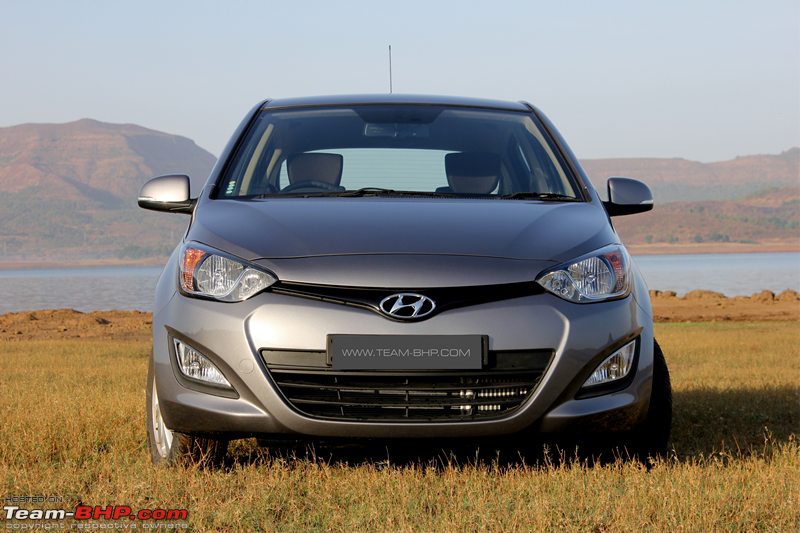 Plain-vanilla side profile is largely unchanged in the facelift: 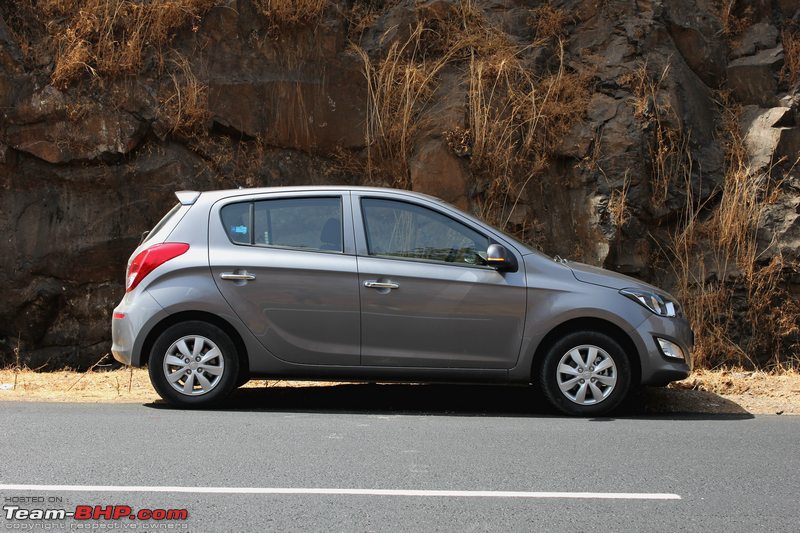 Neat looking rear gets new lamps, bumper & spoiler. Excessive badges create clutter. New bumper increases the length by 55 mm, but the i20 is still a sub-4 meter car (3,995 mm):   Striking headlamps have terrific detailing. Spread & power have improved over the older car:  Foglamp illumination is viewable from the side as well. All the better for safety, we say. Foglamps are larger now, and powerful enough:  Headlamps protrude out noticeably (as do the rear tail-lamps too): 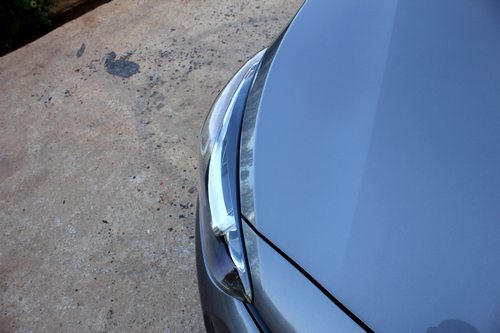 The rain / light sensor for the auto headlamp & wiper functionality. Auto headlamps have a very fast response time:  As long as the key is in your pocket, simply press the black request button (on the door handle) to unlock the i20. Press it again to lock:  Electrically-foldable ORVMs get integrated blinkers:  Notice the rear disc brake, a first for an Indian hatchback. 185/65 R14 Apollo Acelere tyres mounted on 8 spoke alloy wheels. 14" wheels are a size smaller than they ought to be: 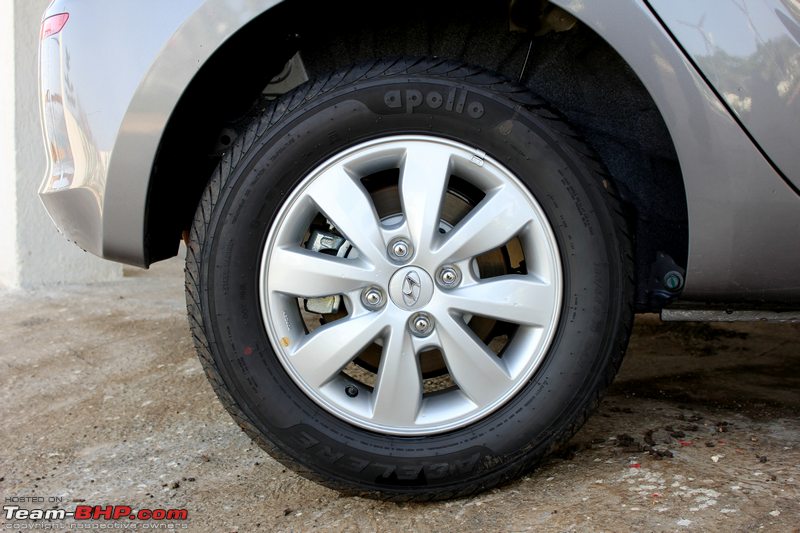 New tail-lamp cluster:  The reverse camera is neatly tucked away under the Hyundai logo:  Prominent new rear spoiler:  Superbly integrated rear washer, underneath the 3rd brake lamp. The driver has to simply press the LHS control stalk to wash & wipe the rear windscreen: 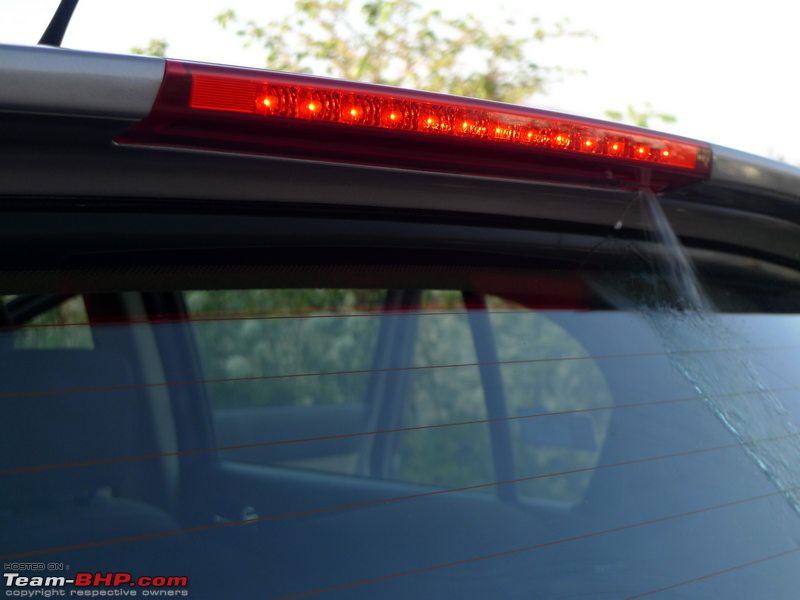 Rear bumper is home to 4 parking sensors:  165mm of ground clearance. Due to the longer wheelbase & soft suspension, the i20 does scrape over large humps when fully loaded (ref : ownership reports of the i20). Rear tow hook is located under the car:    Last edited by GTO : 24th May 2012 at 14:23. |
| |  (27)
Thanks (27)
Thanks
|
| The following 27 BHPians Thank GTO for this useful post: | .anshuman, anjan_c2007, archangelvishal, AutoIndian, dkaile, gearedup, Guna, haisaikat, kevintomin, Leymama, muqtaliff, Patriot_Vishwas, RavenAvi, Rehaan, Reinhard, RSR, S2!!!, scopriobharath, Sheel, sidindica, swiftnfurious, Technocrat, theexperthand, thoma, Turbokick, valapad, vibbs |
| | #3 |
| Team-BHP Support  | re: 1st-gen Hyundai i20 (2008 - 2014) : Review  As long as the smart key is in your pocket, all you have to do is press the black request button (on the door handle) to unlock the i20. To lock the car, simply press this black button again. The request button has been fitted on the driver as well as front passenger doors. The i20's seats are placed on the lower side, and the ease of walking into a tall boy hatchback is entirely absent. Instead, you have to "sit down" onto the seat. The elderly, especially, won't like the effort required to get on or off the back seat. The interiors wear a black, brown & beige colour combination. I'm not a fan of the chocolate brown shade at all. That said, darker colours are sensibly applied to areas that have frequent human touch; the top of the dashboard, door-pads, steering wheel etc. Hence, these areas won't get dirty anytime soon and should be easier to maintain than full-beige interiors. The black colour of the carpeting is similarly practical to live with. The interiors score highly on the feel good factor, while quality & overall feel are superior to most million-rupee sedans. Cabin length and width are comparable more to C-segment sedans than B-segment hatchbacks. Space at the front is impressive, even the taller amongst you shouldn't have any problem fitting in. All controls are logically placed and within easy reach for the driver. Frankly, the user-friendly nature of the interiors is eerily like that of Toyota & Honda cars. The superb front seats are like buckets that you place yourself into. Lateral support, especially, is A+. The driver's seat armrest is perfectly positioned and very comfortable to use; I just wonder why other manufacturers don't make this a standard feature. On the flip side, the seat compound is too hard for Indian tastes. I understand that the i20 was designed for Europe, but Hyundai should have offered softer seats that are more in tune with the preferences of the domestic market. Several i20 owners complain about the firm compound seats. The seat upholstery itself feels durable and should easily last several years of use. With steering rake & reach adjustment, and driver's seat height adjustment, it's easy to find your ideal driving position. The front seats have a reasonable fore & aft travel range. In fact, the seat can be positioned so far ahead that those who are <5 feet in height will feel right at home. Frontal visibility is satisfactory for taller drivers, but the shorter amongst us will complain of the dashboard being placed too high. Yes, short drivers will need to dial up the seat height adjustment (i20 base variants aren't for the short ones). Also, the thick A-Pillars do create unusually large blind spots. They remind me of the ugly blind spots of my Civic. The inside rear view mirror has wide coverage, although the ORVMs (outside rear view mirrors) are a size too small. There is absolutely no dashboard reflection on the windscreen, thanks to the dark colour of the dashboard top. The 4-spoke steering wheel is light & effortless to use, as is the case with most Hyundais. I only wish that Hyundai had made the wheel meatier and given it thumb contours. The gear lever's chrome finish looks tacky in an otherwise nice interior. Also, sunlight does reflect from the chrome lever at noon. This chrome finish had disappeared in some i20 production years...well, it should have stayed that way! The horn pad doesn't extend to the edge of the rim. Unlike the Germans however, the horn pad is softer to press so it's not as bad to use. The straight-forward instrument console is easy to read. The primary MID has a digital speedometer, temperature gauge & fuel gauge. The gear shift suggesting tool is placed between them, and has a large font that is easy on the eyes. Newbie drivers will love this feature, whereby the onboard computer monitors your driving style and suggests the right gear - in real time - to maximise fuel efficiency. In bright sunlight though, there is some glare on the MID and you might have to give it a 2nd look to read the exact fuel & temperature levels. There is another MID placed on the center of the dashboard. The less critical data is displayed on this center MID, including information on the audio system, outside temperature, clock etc. The advantage of a secondary MID is that the primary remains uncluttered. I do find it surprising that height-adjustable seat belts are missing in this otherwise loaded car. Space at the back is good by hatchback standards. Two 5’9" - 5’10" guys should fit in easily one behind the other (on the front & rear seat). There is a lot more room available than the best-selling Swift, and cabin width is also enough to accommodate the occasional 5th passenger. The rear seat back angle could have been more reclined, and some of you might find it to be too upright. The small floor hump isn't much of a hindrance. Still, the Indica Vista & Jazz remain the benchmarks in terms of space. Like the front seats, the rear seats have a firm compound as well. The seat is placed pretty low while the window sill is high. At 5'10", the window sill was 2" above my shoulder. This, combined with the dark coloured surroundings, don't lead to an airy feeling at all. On the other hand, head-room is abundant, thanks to the low seat base. Even 6+ foot occupants won't face any issues. The 2 neck restraints (headrests) do a good job of supporting your neck. However, the shorter folk might find them to be protrusive. Compared to the feel-good front area, it does look like i20 designers ran out of budget by the time they got to the back. For starters, the door pads wear an awfully simple look and don't have any pockets in them either. There is only one seat back pocket behind the front passenger's seat. The rear air-con vents are placed at the foot level and, honestly, wasted. Their sole purpose is to keep the rear passenger's feet warm in extremely chilly winters, the type we seldom see in India. Then, there are the abysmally poor rear speakers. The music system is decent for an OEM unit. Sound quality is acceptable from low to mid volume levels for front seat occupants. AUX, USB & Bluetooth compatibility is standard, while the headunit also supports folder browsing of your MP3 collection. If there is one complaint with the stock audio, it's the weak rear speakers. Even with the fader set at the 50:50 level, rear passengers still get more sound from the front speakers. The effective air-conditioner (especially of the 1.4L diesel & 1.4L AT) was a pleasant surprise. Mumbai was facing hot summer days, yet the i20 kept us sufficiently cool inside. This is also a rare car whose climate control setting goes all the way down to 15.5 degree celcius. However, I did notice that the 1.2L variant took a longer time than the 1.4s to cool the rear cabin area. Hopefully, the recent court order is recalled because high quality sun film is a must-have in the 1.2L i20. All of the 4 front air-vents have air volume control, and the adjustment knob itself has a rich rubbery finish. Storage is a hit (for those at the front) and a miss (for those at the back). I found the large cubicle, right ahead of the gear lever, to be particularly useful. There are 2 large cup holders and 2 other cubby holes around the handbrake area. The glove box is massive and will gobble up your stuff, including a compact laptop. The glovebox even gets a cooling vent for your Coca Colas. I kept my cash in the storage drawer below the climate control (whose lid feels very high in quality BTW). On the flip side, the front door pockets are awfully thin and don't even get bottle holders. Rear passengers will feel short-changed as there aren't any door pockets for their knick knacks. They will have to manage with one seat-back pocket and the cubby hole behind the handbrake. The 295L boot is extremely accommodating and amongst the best from the segment. Further, the boot has a practical layout. For the times that your mother-in-law visits, the rear seat can fold down in a 60:40 ratio. The boot area gets two bag hooks and a useful lamp. Steering wheel is light & effortless to use, though I wish it was meatier and had thumb contours. Integrated stereo control includes a mute button. Steering has rake & reach adjustment:  Instrument cluster with blue back-lighting is easy to read. Primary MID houses the digital fuel & temperature gauges, odometer, digital speedometer, gearshift suggesting tool, door-open warning and the parking sensor display. Speedometer is marked all the way to 220 kph:  Stock system offers good sound quality for front seat occupants, but has extremely weak rear speakers. Has AUX, USB, CD and Bluetooth. Notice the vertical air-con vents? Their design isn't ideal. The throw of air doesn't spread wide enough, and the (airflow) focus area is much too narrow:  Chrome finish on the gear lever looks cheesy! Smooth 6-speed gearbox is superb: 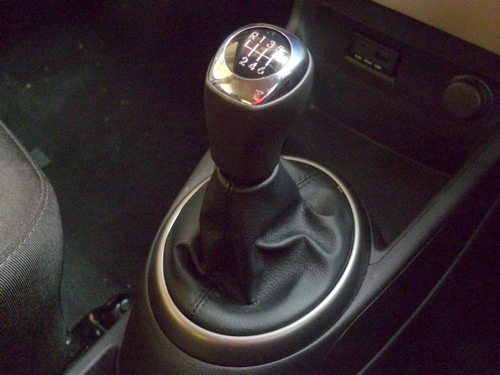 Front seats offer excellent lateral support. Notice the very-nice armrest which makes the driver's seat more like a comfortable couch:  Seat height adjustment is mandatory for shorter drivers. Remember, the i20's seats are placed on the lower side:  The Smart Key need only be parked in your pocket. You don't need to remove the key to lock / unlock the i20, or even start / stop the engine. Smart key does get a boot-release button:  Press the clutch pedal and tap the engine start button to fire the i20 up. Hit this button *without* pressing the clutch to access the stereo on and ignition on modes. Ignition on mode means the lights, blower, power windows etc. work without the engine cranking up: 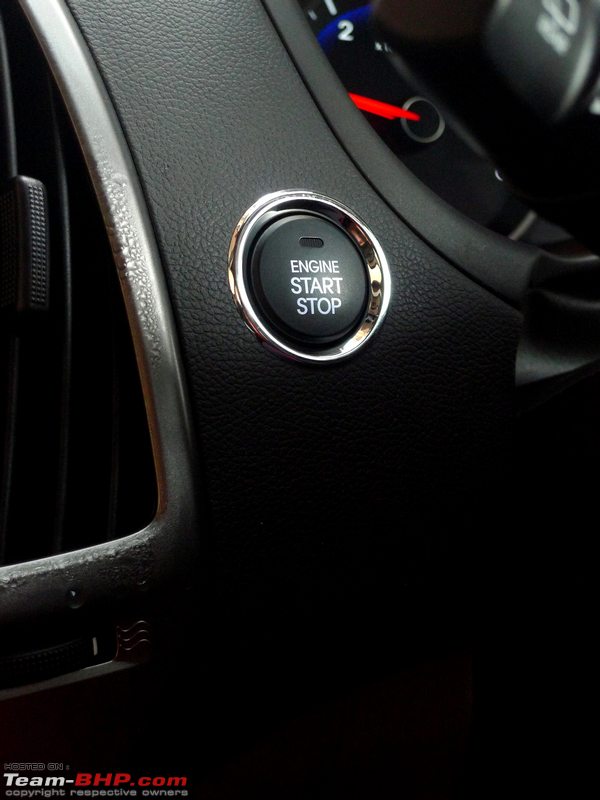 Reverse camera display (on the inside mirror) works like a charm. The green (safe), yellow (caution) and red (stop) colour coding is perfectly calibrated: 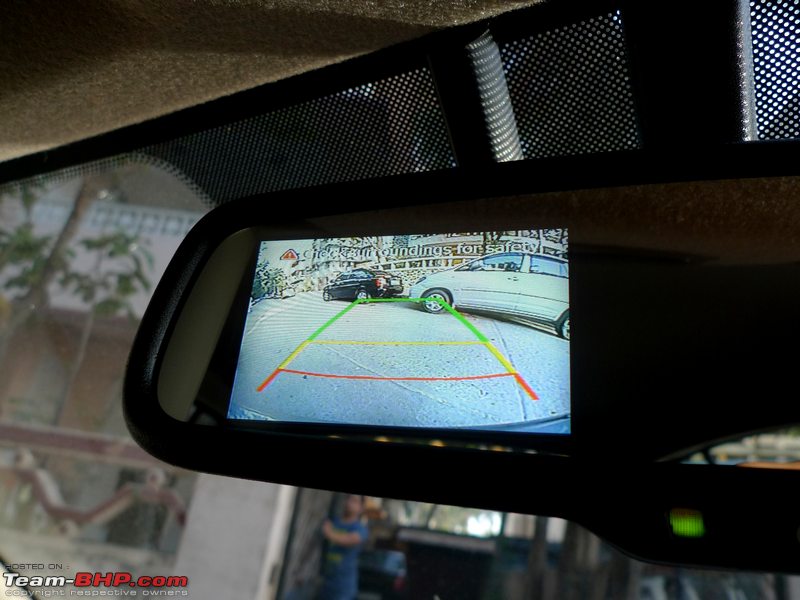 Here, the system is suggesting an upshift to 5th gear. You can also see the digital speedometer in action:  Driver footwell is wide enough. Dead pedal is always welcome:  This is the 2nd MID placed in the center of the dashboard. Among other things, you'll see the two trip meters and audio system data here:  The climate control's effectiveness has noticeably improved in the facelift i20 (especially for the diesel & AT variants). A rare system that lets you take the temperature down to 15.5 degrees. The clean air sticker refers to an air-filtering ionizer. I didn't notice any difference at all, though others commented that the air inside feels fresh:  Stalks feel durable. The LHS stalk has controls for the auto-wiper and rear wash / wipe with intermittent function. Pull it to clean the front windscreen, and push to clean the rear windscreen. The Auto-Headlamp function is activated in this picture of the RHS stalk: 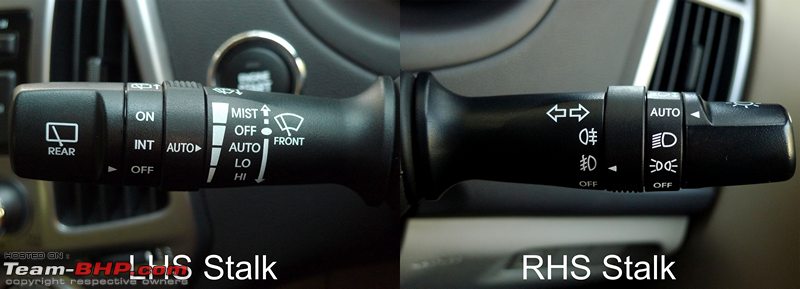 Small door pockets at the front and no bottle holder either. Terribly uninspiring door pad design. Notice the tweeter placed ahead of the door handle:  The topmost button can electrically fold in / out the ORVMs. One-touch-down and pinch protection for the driver's window only. All power window switches are illuminated:  I found the wing mirrors to be a size too small and did have to crane my neck from time to time. They get a heating coil for the snowy & rainy weather conditions:  Vanity mirrors on both sun visors, while the driver-side unit gets a ticket holder too:  USB / AUX inputs, 12V power socket and useful storage cubicle placed right ahead of the gear lever:  Fair amount of storage cubicles around the handbrake area, including the 2 differently sized cup / bottle holders:  Massive glovebox can gobble up your stuff, including a compact laptop. It also has...  ...a cooling function to keep the soft drinks cold: 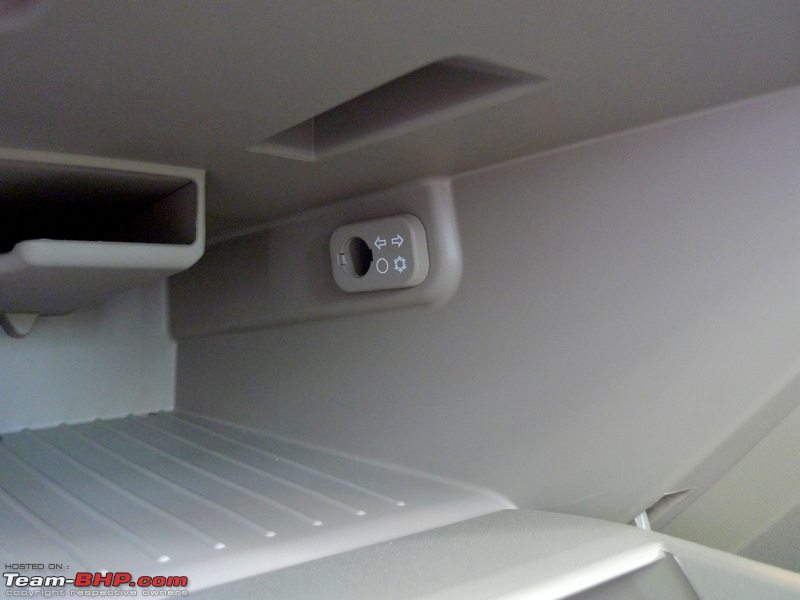 Sufficient rear legroom: 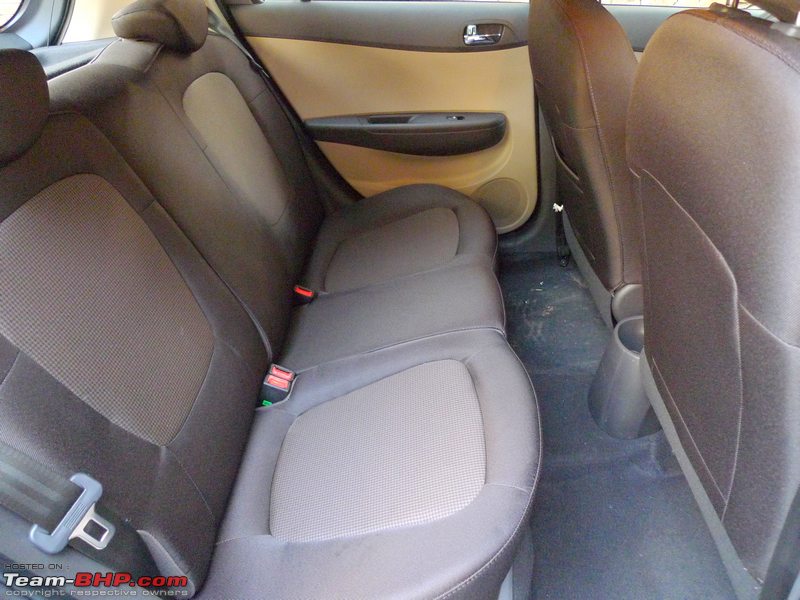 This picture shows the min / max legroom:  Some may find the seatback to be too upright:  The floor hump isn't intrusive at all: 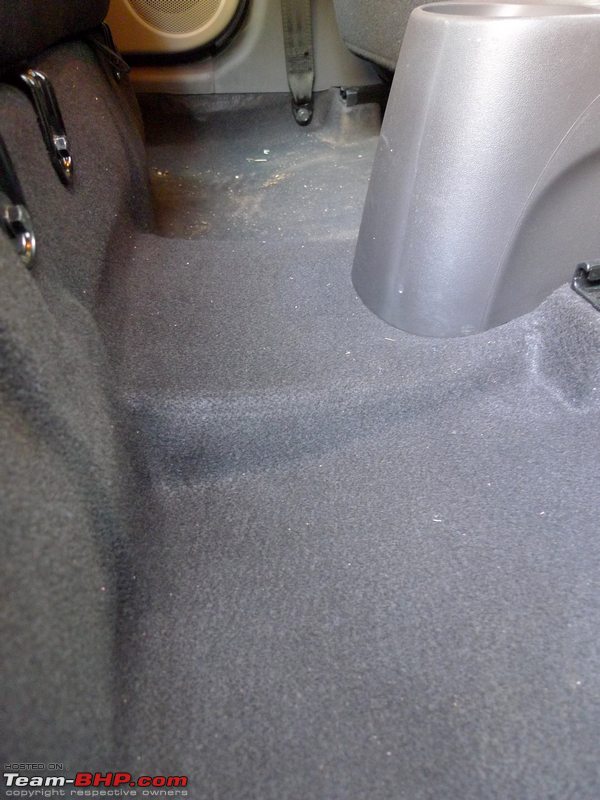 Rear air-con vents are wasted due to their positioning under the front seats:  Huge 295 liter boot has a practical layout. Low loading bay helps at the time of lifting luggage:  The rear seat can fold down in a 60:40 ratio for the times that you need this flexibility:  Last edited by GTO : 25th May 2012 at 14:55. |
| |  (26)
Thanks (26)
Thanks
|
| The following 26 BHPians Thank GTO for this useful post: | .anshuman, A350XWB, anjan_c2007, AutoIndian, DexterMorgan, haisaikat, jkdas, Kimified, lurker, Patriot_Vishwas, RavenAvi, Rehaan, Reinhard, RSR, S2!!!, SaiSW, scopriobharath, Sheel, sidindica, SmartCat, swiftnfurious, Technocrat, theexperthand, valapad, vibbs, _raVan_ |
| | #4 |
| Team-BHP Support  | re: 1st-gen Hyundai i20 (2008 - 2014) : Review  Strange that engine NVH levels are so good, despite the lack of under-bonnet insulation:  You need to press the clutch before firing up the engine: 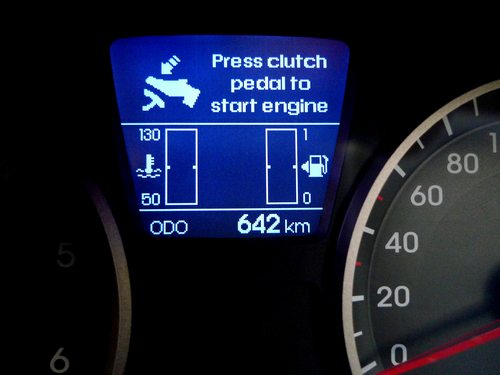 The i20 has the following three engine options: • 1.2L Petrol with 83 BHP (@ 6,000 rpm) and 114 Nm of torque (@ 4,000 rpm). Manual transmission only. ARAI rating = 18.5 kpl • 1.4L Petrol with 99 BHP (@ 5,500 rpm) and 136 Nm of torque (@ 4,200 rpm). Auto transmission only. ARAI rating = 15 kpl • 1.4L Diesel with 89 BHP (@ 4,000 rpm) and 220 Nm of torque (1,500 - 2,750 rpm). Manual transmission only. ARAI rating = 21.9 kpl We have driven & reviewed all three engines for you  The 1.4L Diesel  To start the i20 diesel, simply press the clutch pedal and tap the engine start button. Throttle response just after idling rpm is mediocre; there is definite lag at <1,700 rpm and this does take some getting used to. I didn't find the lag to be much of a bother initially. But there are certain situations where you want instant go, say upon spotting that gap in traffic, and the i20 diesel won't respond immediately. The only option you have here is to downshift. Yes, you will be using the gear lever frequently in dense traffic conditions. I would rank overall driveability somewhere at the middle of the scale, with the Micra / Figo on the positive end and the Polo diesel on the negative. It takes a while to understand the i20's power delivery. Once you spend a couple of kms behind the wheel, you learn how to extract the best performance from this engine. Hyundai has given the i20 a short 1st gear ratio; this helped us on an extremely steep incline where we didn't have to brutally slip the clutch. The turbo starts waking up at 1,700 rpm and by 2,000 rpm, it's on the boil. This is where the action begins. Keep the accelerator pedal buried and the i20 will reward you with performance that is the best amongst diesel hatchbacks. There is no push-into-the-seat feeling though, and power is delivered in a very mature fashion. In fact, at higher rpms, the i20 diesel hardly sounds like an oil-burner. Out on the open road where the other 1.3L MJD hatchbacks would be running out of breath at 130 - 140 kph, the i20 is still accelerating. The car is a fantastic long distance cruiser with loads of highway pep. At 100 kph, the engine is spinning over at just under 2,000 rpms, while 120 kph sees the rpm needle at ~2,300 rpm. In these highway conditions, there is ready torque available. I didn't even shift down from 5th / 6th gear when overtaking others from the fast lane. A gentle nudge on the accelerator does the trick. Because of the power on tap, the i20 diesel feels like it can maintain 3 digit speeds all day, and easily keep up with more expensive machinery. The additional ratio on the 6-speed box allows a better spread of power and the gear ratios are perfectly chosen. The engine revvs clean to 4,500 rpm...even 5,000 rpm, but as is the case with most diesels, there is no point in going so high on the gauge. Even when you are driving spiritedly, upshift no later than 4,000 rpm. The i20's gearbox is smooth to operate. Shift action is light too, and the mass market will love it. The throw isn't the shortest, yet it's eager to slot effortlessly. There is none of the vagueness that we have experienced with the gearboxes of some other hatchbacks. Mated to the gearbox is a light clutch with a relatively shorter throw. This makes the i20 an easy car to drive around. This 1.4L engine is easily the most refined amongst diesel hatchbacks. It never sounds too gruff or too loud, like say the Polo & Fabia diesels. At higher rpms, sound levels are very acceptable and there is none of that ugly drone that we've witnessed in the Punto diesel. In fact, at 3,000 rpm, it sounds more like a thrummy 3-cylinder petrol than a diesel (and I mean that in a good way). As good as the engine refinement is, there are glaring gaps in other areas of NVH. The rear suspension, for starters, is clunky & thuds continuously over broken roads. Tyre noise is on the higher side too. Over some ill-maintained roads, tyre noise can reach annoying levels. The 1.2L Petrol 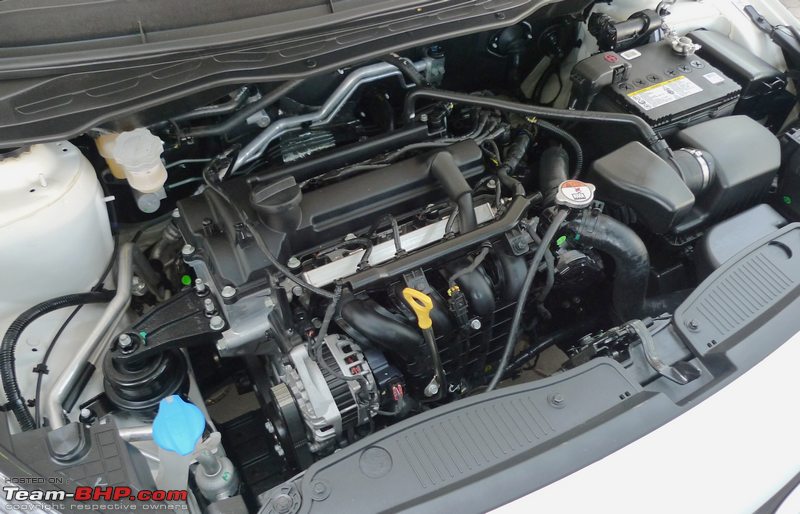 The i20's 1.2L petrol engine receives variable valve tech on the intake & exhaust sides, bumping up power to 83 BHP (@ 6,000 rpm). Max torque is rated at 114 Nm (@ 4,000 rpm). Compared to the older car, power has increased by 4 BHP and torque by 2 Nm. While max torque is made at an identical 4,000 rpm, the facelifted i20 makes its max power a full 800 rpm higher. I do find it surprising that the cheaper i10 received variable valve tech 2 ½ years before the premium i20 though! The engine is unbelievably smooth at idle; the rpm needle is your only indication that the engine is running. Start driving and the i20 feels nearly identical to the outgoing car. Perhaps, a good part of the additional power is being used by the upgraded air-conditioning system as you don't feel the increase in horsepower at all. The i20 1.2L does the job, for the most part atleast, within the city. Power delivery won’t pose a problem to sedate drivers, and urban performance can best be termed as adequate. Those looking at a point A -> point B commuter won’t be disappointed. The initial gear ratios are short, and this does help driveability. Still, because of the car’s mediocre torque to weight ratio, expect to downshift within the city, especially from 2nd to 1st gear. Power delivery is satisfactory up until 100 kph, preferably with a light load of passengers onboard. I must add that the motor sounds really good between 3,000 – 5,000 rpm. So, is the i20 1.2L an all-rounded hatchback like her diesel sibling? No chance. There isn’t a doubt that the 1.2L engine is too puny for a car of this size & weight. Show the i20 petrol any high-stress situation (e.g. highway overtaking) and the result is disappointing performance. Expect to really work the engine when climbing up inclines with a load of passengers. Highway performance is nothing to write home about. Try overtaking a fast-moving target on the expressway and you’ll feel like you have hit a wall. The problem is amplified when you are carrying passengers & holiday luggage. The Swift, Brio & Jazz feel distinctly sprightlier on the highway. At 120 - 130 kph, the engine is already running out of breath. It is best to adopt an easy driving style with the i20 1.2 on the open road. There is no point hurrying up because, if you work the revvs, the 1.2L will neither be fast nor fuel-efficient. It’s just better to accept the limited performance on tap and drive with a light foot. The petrol is nowhere as impressive as the diesel. In fact, I insist that it’s too underpowered for a premium priced hatchback. Atleast in the expensive Asta variants, Hyundai should have given the 1.4L petrol engine as standard. Despite the 4-speed Automatic, the i20 1.4L AT offers superior performance. The 1.2L motor is smooth all through the rpm range, and is very eager to revv too. Cruising at a 100 kph, you won’t hear the motor at all. On the flip side, I did find the clutch throw to be on the longer side. The 5-speed gearbox is exceptionally smooth to use, more so than even in the diesel i20. In a nutshell, the 1.2L does the job in the city, but fails on the highway. Ride quality is acceptably compliant at urban speeds. The suspension is fairly absorbent and stays that way over small to medium sized bumps. No, it's not super plush, yet ride comfort is much improved over the older car. Over the BMC's poorly maintained roads in Mumbai city, comfort levels remained sufficiently absorbent at 50 - 60 kph. On flat highways as well, the suspension will keep passengers happy. On the other hand, the i20 is anything but planted over uneven roads at speed. If you are at 80+ kph, even after leaving the uneven patch behind you, a certain amount of vertical movement remains. This excessive vertical movement on undulating highways can unnerve both the driver & passengers. Further, while small to medium sized bumps are handled well, large bumps do unsettle the car. The i20 is not meant to be a corner carver and it's best to adopt a conservative driving style with this car. Grip levels through corners are safe and predictable as long as the speedometer needle is kept in check. Straight line stability is satisfactory at 120 - 130 kph, while body roll isn't excessive due to the lower ride height. High speed behaviour has improved over the older car, and the typical Indian car owner won't notice anything wrong with the dynamics. Conversely, the enthusiast will be disappointed with the wallowy behaviour when road conditions are less than ideal. The damping is nowhere as superior as in the European hatchbacks. As an example, there is the excessive vertical movement I mentioned in the previous paragraph. Mid-corner bumps also greatly upset the car's composure, and this is a situation frequently experienced on Indian highways. It is best to shed speed before taking corners. Cars like the Figo, Punto and Swift are far more accomplished dynamically. Uneven roads don't ruffle them as much either. Making matters worse is the light steering that feels vague on the highway, and is extremely sensitive at speed. You could switch a lane on the expressway with minimal steering input. Also, through fast corners, the steering puts in deliberate resistance that is just too artificial in feel. Over a 100 kph, it's very important to keep a firm hand on the steering as it reacts much too quickly for comfort. The car's straight line stability is actually better than the video-game steering would have you believe. While the suspension will suit mass market tastes, it is not properly tuned, as is the case with all Hyundai cars. Hyundai engineers just aren't able to hit that sweet spot between ride and handling. Wider tyres & 15" rims could noticeably improve the dynamics. I'm not in agreement with the OEM size of 185/65 R14 (higher variants) or 175/70 R14 (Era & Magna variants). 195mm tyres on the stock 14" wheels, or an overall upgrade to 195/55 R15, is what I highly recommend keeping the diesel's power & torque figures in mind. The i20 has 165mm of ground clearance. Due to the longer wheelbase & soft suspension, the car does scrape over large humps when fully loaded (ref : ownership reports of the i20). The turning radius of 5.2 meters is noticeably larger than that of the Swift (4.8 meters) and could lead to that many more 3-point turns within the city. Unlike the dynamics, the i20's brakes are absolutely top class. Our test car, equipped with discs on all 4 wheels and ABS / EBD, was spot on in the braking area. We found that the car maintains its line even under heavy braking conditions, the hardware & ABS working just as intended. The i20 1.4L diesel runs like a horse on the expressway. Unfortunately, this isn't the case with the 1.2L petrol:  185mm tyres are unsuited to the diesel i20's performance. I recommend an upgrade to high quality 195mm rubber:  Last edited by GTO : 1st June 2012 at 10:09. |
| |  (16)
Thanks (16)
Thanks
|
| The following 16 BHPians Thank GTO for this useful post: | .anshuman, anjan_c2007, haisaikat, jkdas, kryptonite, lurker, RavenAvi, Rehaan, RSR, Safedriver76, scopriobharath, Sheel, Torquedo, Turbokick, valapad, vibbs |
| | #5 |
| Team-BHP Support  | re: 1st-gen Hyundai i20 (2008 - 2014) : Review The 1.4L Automatic  The i20 Automatic gets a 1.4L petrol engine with 99 BHP (@ 5,500 rpm) and 136 Nm of torque (@ 4,200 rpm). Start the engine & the supremely refined idle is immediately apparent. Shift the gear position into D and your left arm / leg can relax away to glory. Throttle response from 0 kph is excellent, thanks to the conventional torque converter gearbox. Piloting the i20 AT within the city is an effortless exercise, and engine noise is barely audible under a regular driving style. The 1.4L engine overall feels far peppier than the 1.2L MT, even with the automatic gearbox. For the times that you want to suddenly close that gap in traffic, the gearbox does take a moment to respond, yet it’s nowhere as lethargic as the Vento AT (as an example). This is definitely not a gearbox I would call lazy, with the kickdown response time being reasonably good. Spend a couple of kms driving the i20 AT and you’ll get completely accustomed to the engine & gearbox characteristics. You'll even learn how to press the accelerator just that much to invite a downshift. The light steering adds to the manoeuvrability factor...you can dart in & out of traffic with ease. I found the otherwise chaotic Mumbai evening traffic a breeze to tackle with the i20 AT. The engine upshifts early, at anywhere between the 1,750 – 2,000 rpm mark within the city. At 50 kph, the 1.4 is spinning over at a mere 1,500 rpm in 4th gear. With a light foot, the experience is very seamless, smooth and stress-free for the driver as well as passengers. 100 kph cruising speed has the rpm needle hovering at 2,600 rpm. With 99 BHP on tap and a fairly competent autobox, you can make fast progress on the expressway. In a pedal to the metal driving style, the gearbox will upshift at 5,800 – 5,900 rpm. The i20 has noticeably more muscle than its 1.2L sibling and can reach high speeds effortlessly, still having grunt for more. Yep, the i20 AT will pleasantly surprise you on the expressway. In L, 2 and O/D off modes, the engine will revv to a max rpm of 6,500 in the 1st, 2nd and 3rd gears (respectively). No issue with the brakes as the i20 AT gets disc brakes on all 4 wheels. This is a welcome move, more so in an automatic car. As the rpm needle rises however, the 1.4L engine feels a generation too old compared to the 1.2L Kappa2 / VTVT series. It sounds quite unpleasant at 4,000 rpm, while the motor throws out an annoyingly boomy sound over 5,000 rpm. Noise aside, the 1.4L throws out no vibrations, even at 6,000 rpm. The overdrive (4th gear) off button is located on the right side of the gear lever. Engaging O/D off makes 3rd the highest gear that the engine will use. This feature might be handy when driving on fast, hilly stretches of tarmac. I found the O/D off button particularly useful when overtaking too. Example : If you want to overtake that fast bus in front, press the O/D off button and the i20 AT will immediately shift down to 3rd gear. This allows you to build up the revvs and get the engine into its power-band before moving out for that overtaking manouveur. If you engage the L mode, the gearbox will provide drive in 1st gear only. Use this for extremely steep inclines or declines. There is also a level 2 that won’t take the car above the 2nd gear ratio. It’s very easy to use engine braking in the i20 AT. If you are cruising in 4th gear, simply press the O/D off button for 3rd gear engine braking. You can similarly engage the “2” and “L” gearbox modes for 2nd & 1st gear engine braking. The i20’s computer does account for over-revving and won’t let the gearbox shift down if the resultant rpm is too high. For instance, if you engage “L” mode at 60 kph, the gearbox won’t shift down to 1st until the speed drops to 45 kph. There are two main downsides to the Hyundai i20 Automatic. One, the price. Depending on which city you are based in, the on-road price will be in the range of 8.5 – 9.0 lakh rupees. Further, the i20 Automatic was available in the Asta trim level earlier but with the facelift, you can only buy the AT in Sportz trim. Strangely enough, there isn't much of a price difference between the two (i.e. the old Asta and the new Sportz). The second disadvantage is the running cost. Petrol ATs aren’t known for their fuel efficiency. Expect 8 – 9 kpl, depending on the driving style & conditions in a metropolitan city. Automatic badging on the fender:  The AT gets rear disc brakes too:   Notice the gear position indicator (next to the odometer):   The smaller "O/D Off" button:  Dead pedal is particularly useful in the Automatic i20:  The lower variant's flippy key. Only the Asta variants get the smart key:  Last edited by GTO : 28th May 2012 at 13:08. Reason: Fixing italics tag |
| |  (21)
Thanks (21)
Thanks
|
| The following 21 BHPians Thank GTO for this useful post: | .anshuman, anjan_c2007, Blue Thunder, dkaile, Ertigiat, haisaikat, NirmalK, nukeblitz, Patriot_Vishwas, RavenAvi, Rehaan, Reinhard, RSR, scopriobharath, Sheel, sidindica, SmartCat, theexperthand, Turbokick, valapad, vibbs |
| | #6 |
| Team-BHP Support  | re: 1st-gen Hyundai i20 (2008 - 2014) : Review Other Points: • Hyundai's 1st big hatchback, the Getz, royally flopped in our market. The Getz actually created the B+ segment in India. The market wasn't ready to pay that kind of money for a hatchback at the time, and the Swift's later arrival eventually sealed the Getz' fate. While space for the i20's rear seat passengers is decent, the Getz was definitely roomier. And the Getz 1.5L diesel was quite the torque monster! Its power delivery was brutal in comparison to that of the i20 diesel. • I'm a huge fan of extended warranties and give Hyundai full marks for the 5 year extended warranty option on the i20 Petrol. Equally, I'm miffed about the i20 diesel getting a maximum cover of only 3 years. Why this discrimination, Hyundai? It's probably because the diesel engine is fully imported and component costs are very high. The potentially high repair costs are something you should keep in mind. • While Hyundai insists that the steering rattle issue has been taken care of, we should wait for confirmations from actual owners of the facelifted i20. • The NCAP included the European i20 in its list of the "Top 5 safest cars" in 2009. Yep, the i20 has received a 5 star safety rating in the NCAP tests. • If you hit the start button *without pressing the clutch*, only the stereo will receive power the first time. Hit the start button again and the system moves into ignition-on mode. • I consider the diesel i20 to be a terrific all-rounder. This isn't the case with the under-powered 1.2L petrol variant. • The meek OEM horn doesn't suit the car's premium positioning. However, the dual horn hardware means that the i20 is equipped with a relay from the factory itself. This makes upgrading to a powerful, after-market horn easier. No wiring needs to be changed or altered. • It's hard to believe that this premium hatchback is built by a company that was only known for bargain basement products in the early nineties. Hyundai & Samsung, both Korean companies, have a lot of things in common. Their emergence to the forefront is built solely on high quality products. As they say in the automotive world, there is no problem (for the company) that a good car cannot solve. 4 days with the i20 and it leaves a lasting impression in terms of quality. P.S. My cell phone is a Samsung Galaxy S. • Even after the car is switched off, the power window controls work for a couple of seconds, giving you enough time to roll up any open windows. The electric-folding ORVMs also work after the engine has been switched off. Neat. Interestingly, the electric power steering stays active and super-light for ~5 seconds after turning off the car. This is probably convenient in countries where you are required to turn your wheels when parking on a slope. Wishlist : Making the mirrors fold out / in automatically when you unlock / lock the car. • Don’t ever press the CD eject button with the ignition off. This leads to the stereo system fuse popping out. A known bug with this head unit. • Your Hyundai dealer will willingly enable auto-locking doors for you. They can set the doors to lock at an exact 40 kph. • Even the rear wiper has an intermittent timer! • As impressive as the interior quality is, the Skoda Fabia's interiors are still the best built. Without doubt, the benchmark among hatchbacks. • The i20 diesel saw a temporary shift from a 6-speed to 5-speed gearbox when the Fluidic Verna's launch led to supply constraints (Related discussion). • The same 1.2L petrol makes the i10 a hot hatch, but the i20 a slow coach. Reason? WEIGHT! The i20 weighs 200+ kilos more than the i10. • The facelifted i20 has a seatbelt warning for the driver only. This is unlike in the older car where the system would keep an eye on passenger seatbelts too. • Indicator stalk gets a one-touch lane change function. You just have to tap on it once for the indicator to blink thrice. • Driver armrest is really (I mean, REALLY) missed in the i20 Automatic. • The i20 Asta variant gets 2 "door open" warnings! One on the MID, and the 2nd is the default display of the lower variants. • Missed opportunity = A diesel Automatic i20. Petrol ATs won't make further headway with the current fuel prices being where they are. A diesel i20 AT would be a superb urban commuter. • The i20 petrol (not the diesel) is equipped with a smart pedal system. In an emergency braking situation, inputs of the brake pedal will take precedence over the accelerator pedal. • The i20's doors will automatically unlock in case of a major accident. • If you end up with the cheesy chrome gear lever, offer a free swap to any Era / Magna variant owner. Knowing the masses fascination with all things chrome, they should be only too happy with the exchange. • The fuel tank's capacity is 45 liters. Diesel i20 will deliver a phenomenal tank range. • Interiors have a blue back-lighting effect at night. • I noticed a lot of BHPians speaking highly of the new Bronze colour. You might want to check it out if you are considering buying this car. • Sidindica's excellent i20 review is located at this link. Last edited by GTO : 25th May 2012 at 09:27. |
| |  (22)
Thanks (22)
Thanks
|
| The following 22 BHPians Thank GTO for this useful post: | .anshuman, Cayman360, Ertigiat, Gannu_1, h@r$h@l, horabonny, noopster, Patriot_Vishwas, RavenAvi, Rehaan, Reinhard, RSR, scopriobharath, Sheel, sidindica, SmartCat, swiftnfurious, Technocrat, valapad, vibbs, wilful, _raVan_ |
| | #7 |
| Team-BHP Support  | re: 1st-gen Hyundai i20 (2008 - 2014) : Review The Smaller & Significant things: A picture with the entire rear seat folded down. If you need it absolutely flat, refer to this post: 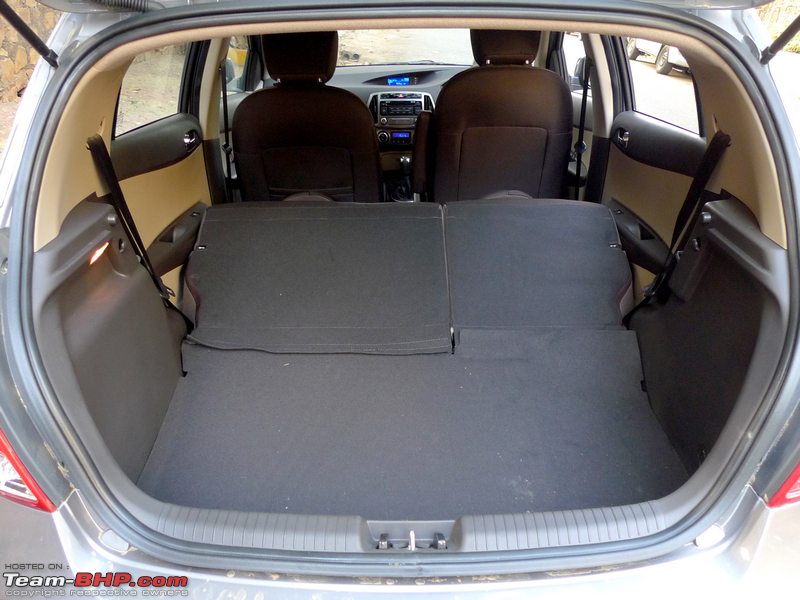 DARK button switches off the center MID screen, if you prefer it that way when driving at night. It's the smaller details, really:  A single seatback pocket! Considering there aren't any door pockets at the rear, a 2nd seatback pocket would have been welcome:  Front passenger door gets a request button as well. The passenger door locking / unlocking (even from the inside) is hooked up to the central locking system:  Two cabin lamps, one at the center with the other at the front. Useful:  RHS steering-mounted controls for your bluetooth-paired phone. And yes, these audio / phone controls are illuminated:  When the battery of your smartkey runs dry, simply pull out the skeleton key to open the car:  Headlamp detailing is fantastic:  Once bitten, twice shy?! A card listing air-con tips can be found in the glovebox of every new i20:  Inside mirror is wide enough:  It also gets an electro-chromatic feature that automatically dims the mirror when it senses headlamp glare from the vehicle behind:  The camera display is effective even when reversing into a completely dark area. The building here had absolutely no lighting:  Proximity display (parking sensors) on the MID. This is over and above the reverse camera display:  The door-ajar warning shows you which door is open:  Rear windows do roll completely down:  The rear door pad is even more boring than the front. No door pockets either:  A surprising omission in an otherwise loaded car. No height-adjustable seat belts for the i20:  Useful storage cubicle on the center console. The lid feels sturdy too:  Rearward view for the driver. In this age of cameras and parking displays, I still prefer reversing the ol' fashioned way: 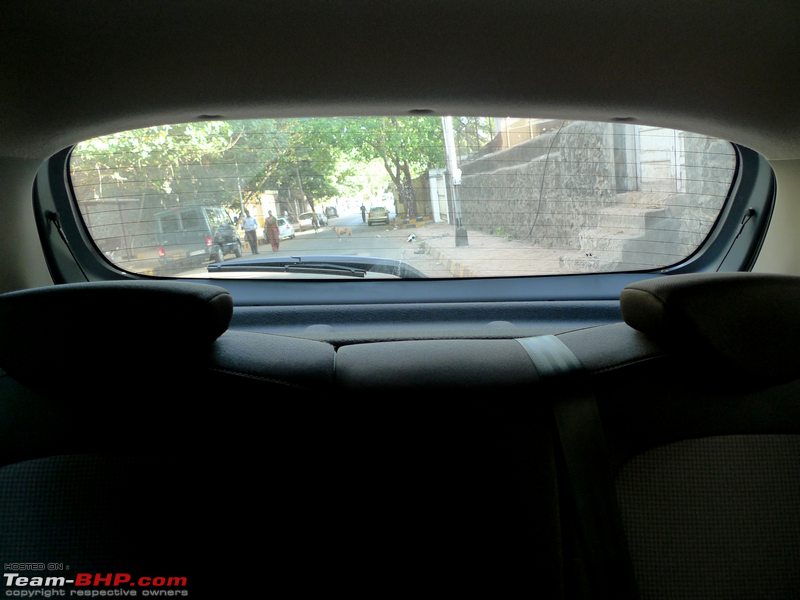 The spare is NOT an alloy wheel. We found out the hard way:  Boot area gets a light and two bag hooks:  Great attention to detail. Properly fitted rubber dampers to prevent parcel tray rattles. You can see Maruti's cheaper version here:  The seat upholstery is durable. Dark colour means no cleaning headache. However, the seat compound is much too firm for our tastes:  You have to pull that button up to engage reverse gear:  Yet another example of the attention to detail in this car. Notice the blue backlit marking for the headlamp beam height adjustment:  Bluetooth phone mic is placed on the roof, right above the driver:  A parting shot. Thanks to Rehaan for help with shooting the pictures, and to him & Parrys for accompanying me on this drive:  |
| |  (28)
Thanks (28)
Thanks
|
| The following 28 BHPians Thank GTO for this useful post: | .anshuman, AutoIndian, Blow Horn Ok, dkaile, Ertigiat, haisaikat, MYB, needforspeed88, raj_5004, RavenAvi, Rehaan, Reinhard, rishie, Roshan_v_k, RSR, scopriobharath, Sheel, sidindica, SmartCat, swiftnfurious, Technocrat, theexperthand, thoma, Turbokick, Varun_HexaGuy, vgsr, vibbs, _raVan_ |
| | #8 |
| Team-BHP Support  | re: 1st-gen Hyundai i20 (2008 - 2014) : Review Chief Competitors of the Hyundai i20 What you’ll like: • Snazzy styling packs appeal. Interiors are well-designed too • Competent engine range. Very refined motors • Balanced ride and handling. Superbly tuned suspension • Terrific fuel efficiency, especially from the diesel • Effortless to drive in the city; lots of fun on the highway • Maruti’s excellent after-sales service & wide dealer network What you won’t: • Small, impractical boot. Luggage capacity is severely restricted • Mediocre brakes (LXi / LDi & VXi / VDi). Inadequate for emergency braking conditions • Looks nearly identical to the outgoing generation car • Rear seat space, though improved, still isn't "spacious" • Pricey ZXi / ZDi variants. Also, ABS no longer an option on the middle “V” variants • Long waiting period for delivery. Runs over 6 months in some cities What you'll like: • A well-built solid European hatchback • Clean and contemporary styling. Absolutely no quirkiness • "Big car like" ride quality. Suspension setup ideal for Indian roads • Neutral handling & mature road behaviour • Fuel efficient range of engines • 280 liter boot. Figo-like & substantially larger than direct competition What you won't: • Commuter 3-cylinder engines. Neither hits the sweet spot nor matches the segment benchmarks • Some niceties missing. Climate control, USB / AUX audio input, electric ORVMs etc. • Ordinary rear bench legroom. Comparable to the Ritz • Thin 40 dealership network • VW's cost of ownership is yet unknown territory What you'll like: • Robust build and construction • Interiors more comfortable than chief competitors i10 & Swift • 1.4 Diesel's proven driveability and fuel efficiency. No turbolag • The Ford Figo's mature big-car-like ride quality • Ford's DNA in the on-road behaviour and quick steering • Class-topping 284 liter boot space What you won't: • Lacks the modernity of recently launched hatchbacks • Both of the engines in the Figo are lacking in outright performance. Neither engine can exploit the car's dynamics • Niggles & irritants, as reported by existing Figo owners • Average backseat legroom. Not in the league of, say, an Indica Vista • Ford's sub-par dealership experience What you'll like: • A neutral family hatchback with the "T" badge • Spacious interiors can easily carry 5 adults • Super light controls, especially steering & short-throw clutch. Effortless to drive within the city • Well-tuned suspension. Safe handling and flat ride • Safety package (Airbags, ABS & EBD) optional on middle variant too • Toyota’s fuss-free ownership experience & excellent after-sales What you won't: • 1.2L engine lacks bottom end; isn't a class-topper like the Etios 1.5 (from which it is derived) • Cost-cutting glaringly obvious in many areas • Economy-grade interior quality & unconventional dashboard • Missing equipment (climate control, height adjustable driver's seat etc.) • Poor insulation. Engine, suspension & road noise are prominent What you'll like: • Variety of engine options (Tdi, Quadrajet, Safire65, Safire90). Take your pick! • Well-equipped from the second variant & over • New interiors look and feel much better in terms of overall quality • Improved gearbox, light clutch and light steering make for effortless city driving • Spacious interiors. Roomiest in the segment; beats some sedans from 2 segments up • Absorbent, comfortable ride quality What you won't: • Fit and finish need improvement. Exterior panel gaps are inconsistent too • Soft suspension setup. Best driven sedately • Centrally-mounted instrument cluster takes some getting used to • Niggling issues & irritants persist (as reported by existing Vista owners) • Tata’s after-sales-service remains a gamble What you'll like: • Cheeky styling. A touch of retro too • Quality, well-designed, interiors • Driver airbag standard across the range (including base variant) • Diesel engine offers stunning driveability. Fuel efficient as well • Compliant ride quality. Suspension tuned for comfort • Gizmos : Keyless entry & go, engine start / stop button, electric folding mirrors, climate control What you won't: • Ordinary three-cylinder petrol engine. Dull to drive • ABS brakes removed from the diesel Micra • Inexistent under-thigh support from the rear seat • Quirky design may not be to your taste • The wafer-thin dealer network • Nissan's cost of ownership is yet uncharted territory Honda Jazz What you'll like: • Premium build & quality • Extremely spacious interiors • Fuel efficient, revv happy engine • Flexible storage solution (magic seats) • Light & easy to drive. An excellent city car What you won't: • Ride quality has stiff edge at low speeds • Low rpm torque delivery is weak • Poor level of equipment What you'll like: • Stunning design. Easily the most stylish hatchback on our roads today • Fuel efficient diesel • Mature & superb ride quality • Outstanding high speed dynamics. The new benchmark (amongst hatches) • Perfectly calibrated & weighted power steering. Deserves a mention here • 5 star safety, ABS & airbags (even on the diesel variant) What you won't: • Rear bench space. Cosy interiors by big hatch standards. Not an Indica Vista • Interior fit, finish and quality are strictly average • Low FE of the petrol • Lack of outright performance. No high powered engine (a la Palio 1.6 100 BHP) • Engine noise at speed (petrol and diesel both) • Service network not a match of say, Maruti or Hyundai Last edited by GTO : 24th May 2012 at 14:14. |
| |  (22)
Thanks (22)
Thanks
|
| The following 22 BHPians Thank GTO for this useful post: | .anshuman, amitwlele, AutoIndian, Blow Horn Ok, dmplog, kalpeshc, kevintomin, Leymama, lurker, nair, PAVAN KADAM, PSOPS, RavenAvi, RSR, scopriobharath, Sheel, Shome, sidindica, spiritofdriving, Technocrat, vibbs, _raVan_ |
| | #9 |
| Senior - BHPian Join Date: Jun 2007 Location: Delhi
Posts: 4,901
Thanked: 8,350 Times
| re: 1st-gen Hyundai i20 (2008 - 2014) : Review Once again, a cracker of a review, rush! pleasant surprise while the nation is grappling with the shocker of a petrol price hike. When I drove both the cars, I was litrelly shocked at the U2's refinement and power on tap. I ranked it the best straightline performing hatchback, but getting used to its driveability will take some time. It ain't a micra/ pulse/ figo or 2012 punto in terms of the in gear acceleration, but its clearly a highway mile muncher. As usual, its marred by less than steller dynamics unlike the punto 90, which makes it a highway star, if only its engine was tweaked correctly... The petrol is typically hyundai-load it with equipment and price it decently and let the market lap it. The engine is terribly uninspiring and sluggish, sadly and dual VTVT on paper hasn't translated to the same thing on road. The verna's success at its price point has made Hyundai (over?) confident and this results in the 8.5 lakh OTR pricing of the i20 diesel asta in Delhi. Still, on my trips in and around punjab, I have started to see the diesel selling strongly. Al the amenities of a saloon at the size of a hatchback, perfect for congested city spaces. At one end, overall I was just about impressed with the i20. Jack of most trades, master in none. Second best selling supermini (after the swift) with its weaknesses supposedly addressed. Give the market what it wants and Hyundai is master in that. Even if it means that engineers still cannot fine tune the steering and suspension the way Fiat does it. My picks would still be the jazz (petrol) and Figo (VFM diesel); Punto 90 (highway oriented diesel) and swift (sensible all rounded diesel). I 20-hmm...a rich boy's toy maybe? Last edited by sidindica : 23rd May 2012 at 23:33. |
| |  (7)
Thanks (7)
Thanks
|
| The following 7 BHPians Thank sidindica for this useful post: | aditya116, AutoIndian, Cayman360, GTO, rameshnanda, RSR, supremoo |
| | #10 |
| BHPian Join Date: Jan 2006 Location: TecHalli
Posts: 334
Thanked: 294 Times
| re: 1st-gen Hyundai i20 (2008 - 2014) : Review Brilliant review my friend. Rated 5 stars. Thanks to you and sidindica to bring up reports on the fluidic i20. I too had a short test drive of the diesel version a couple of weeks ago. Amazed by the power the car had. I have shortlisted this along with the new swift and punto90 HP. Heart says i20 but mind is confused between swift and punto. Worried about the after sales costs of Hyundai and the lack of space in the swift. Yet to check out the punto in detail. Cheers |
| |  ()
Thanks ()
Thanks
|
| | #11 |
| BHPian Join Date: May 2012 Location: Manali
Posts: 261
Thanked: 598 Times
| re: 1st-gen Hyundai i20 (2008 - 2014) : Review An awesome review GTO. Taking care of even the finest of details. Thanks a lot. The equipment level on offer in this car should wake up the other manufacturers as well. |
| |  ()
Thanks ()
Thanks
|
| |
| | #12 |
| Senior - BHPian Join Date: Nov 2007 Location: Bangalore
Posts: 4,189
Thanked: 4,638 Times
| re: 1st-gen Hyundai i20 (2008 - 2014) : Review Thanks for the nice review. Personally I dont like the new design language of Hyundai. Getz (with the original grill) was the most close to the European design but the new Hyundai's are over designed/detailed. They don't look purposeful IMHO. Frankly I dont see any synergy between the VW design and the i20 styling and on the other hand I feel they are very different. But what is more surprising is the compromise on some of the utility aspects like the door pockets. |
| |  ()
Thanks ()
Thanks
|
| | #13 |
| BHPian | re: 1st-gen Hyundai i20 (2008 - 2014) : Review Great Report with superb pics and details. Hats off. I completely hated the the front looks of the new i20. But in flesh, it does look good. A more sensible pricing and better ride & handling would have made this car a perfect buy. But we don't get everything in a single package. I see this car to be a super-hit among aam-junta who needs premium look and feel and doesn't care much about dynamics. |
| |  ()
Thanks ()
Thanks
|
| | #14 | |
| Senior - BHPian | re: 1st-gen Hyundai i20 (2008 - 2014) : Review Excellent review as usual  Quote:
A person who buys this car by paying almost around 9L will always have in the back of this mind that keeping the car more than 3 years might be tough . I hope this doesnt give a wrong indications about the CRDI engine. Also a person who pays that much of money expects the spare also to be alloy wheel  Cheers Last edited by Schoudhury : 23rd May 2012 at 23:52. | |
| |  (1)
Thanks (1)
Thanks
|
| The following BHPian Thanks Schoudhury for this useful post: | GTO |
| | #15 |
| BHPian Join Date: Oct 2011 Location: Mumbai/Margao
Posts: 634
Thanked: 284 Times
| re: 1st-gen Hyundai i20 (2008 - 2014) : Review As usual.. The perfect GTO review..!! Nevertheless, I was never a big fan of the i20, and reading this hasn't changed that opinion much. I would still take the Swift or Punto over this car.. Maybe I've got just too much resistance to change.. phew! |
| |  (1)
Thanks (1)
Thanks
|
| The following BHPian Thanks swarnava.m for this useful post: | sabsubs |
 |




